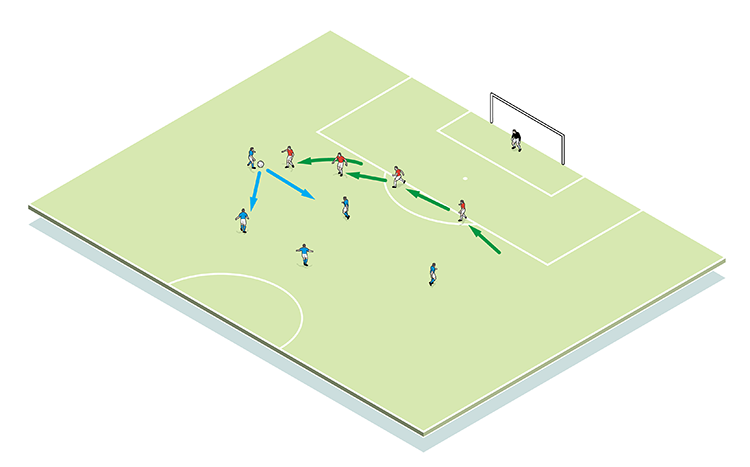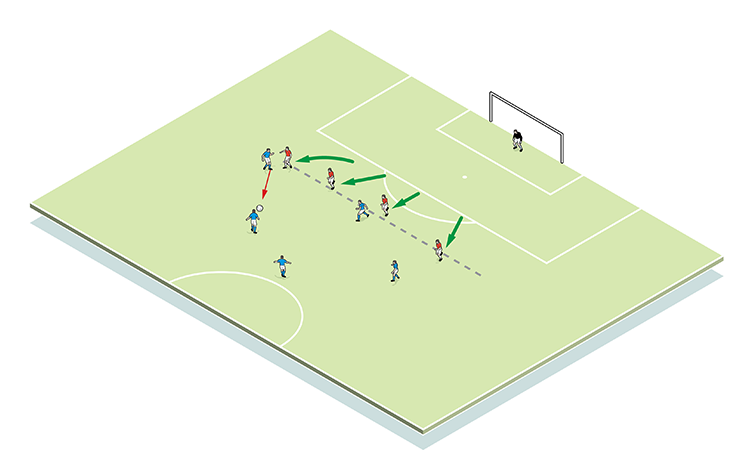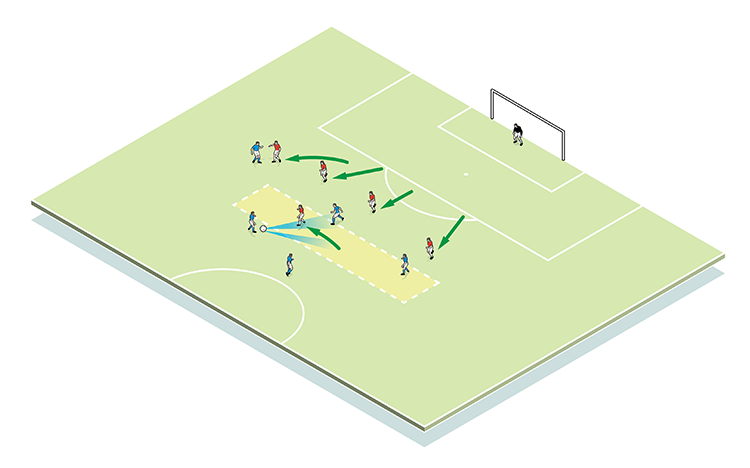You are viewing 1 of your 1 free articles
Dominant defending
Main session 20mins, Progression 10mins
| Area | Half pitch |
| Equipment | Balls, goals |
| No. of Players | Up to full squad |
| Session Time |
Main session 20mins, Progression 10mins |
This session is about defending using, organising and managing a back four, with one defensive midfield player.
It goes without saying, not conceding in matches offers a statistical and psychological boost to every player, breeding confidence and cementing an ‘all for one’ attitude, so keeping clean sheets is always a good principle onto which we might construct a measured gameplan.
This is a practice that is match specific, so its use is obvious and can be applied to every game we play.
What do I get the players to do?
We set up as shown on a full pitch, with a back four and a defensive midfield player in position. We can build the offensive elements as the practice progresses, to a point where we may have two strikers, two wingers, two attacking midfielders and two attacking full-backs attacking this bank of players. In the initial set-up, however, we are looking to cement defensive principles with a simple back four and a handful of attackers.
Staying narrow (1)
The first principle must be that the back four play narrow. Balls should never be played between them, so players must be equally spaced and always aware of left and right threats.
1

Reacting to a wing attack (2)
If the ball is played wide, the defensive reaction must be to shuffle across and stop the threat. Preventing the forward pass is the key aim, so defenders must try to get the opposition to play the ball back or square. They do this by ensuring the nearest defender confronts the player, with other team mates staggering their moves towards the ball whilst still covering as much of the full width as possible.
2

Pressing the retreat (3)
If the ball is forced back down the pitch, the back four must squeeze up in a line, pressing the attacking threat and suffocating space. It’s essential that players move up in a line together.
3

Using a defensive midfielder (4)
When the opposition use a lone attacker to disturb the defensive line, we will bring in a defensive midfielder, whose job it is to stop the pass into the forward’s feet. He does this by getting in the line of the ball and player.
4

How do I progress the session?
To enhance the challenge for the defenders, we can allow an overlapping full-back to get behind his opposite man. This means the defensive midfielder will now need to slot into the spot vacated by the central defender.
What are the key things to look out for?
The back four must stay narrow, communicating well at all times and being alert to attacking runners. Covering must be automatic should a defender get pulled out of position, and the intention of pushing up and suffocating space increases the chances of the press turning over possession.
Related Files
Editor's Picks
Deep runs in the final third
Using the goalkeeper in build-up play
Pressing principles
Intensive boxes drill with goals
Penetrating the final third
Creating and finishing
My philosophy
Pressing initiation
Compact team movement
Coaches' Testimonials

Alan Pardew

Arsène Wenger

Brendan Rodgers

Carlos Carvalhal

José Mourinho

Jürgen Klopp

Pep Guardiola

Roy Hodgson

Sir Alex Ferguson

Steven Gerrard
Coaches' Testimonials

Gerald Kearney, Downtown Las Vegas Soccer Club

Paul Butler, Florida, USA

Rick Shields, Springboro, USA

Tony Green, Pierrefonds Titans, Quebec, Canada
Join the world's leading coaches and managers and discover for yourself one of the best kept secrets in coaching. No other training tool on the planet is written or read by the calibre of names you’ll find in Elite Soccer.
In a recent survey 92% of subscribers said Elite Soccer makes them more confident, 89% said it makes them a more effective coach and 91% said it makes them more inspired.
Get Monthly Inspiration
All the latest techniques and approaches
Since 2010 Elite Soccer has given subscribers exclusive insight into the training ground practices of the world’s best coaches. Published in partnership with the League Managers Association we have unparalleled access to the leading lights in the English leagues, as well as a host of international managers.
Elite Soccer exclusively features sessions written by the coaches themselves. There are no observed sessions and no sessions “in the style of”, just first-hand advice delivered direct to you from the coach.









